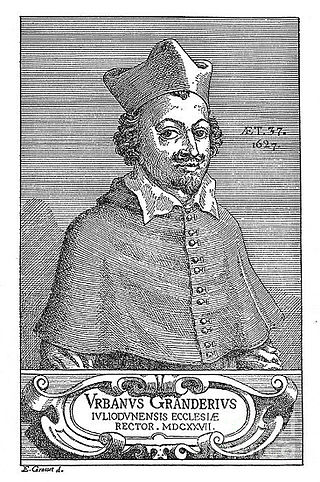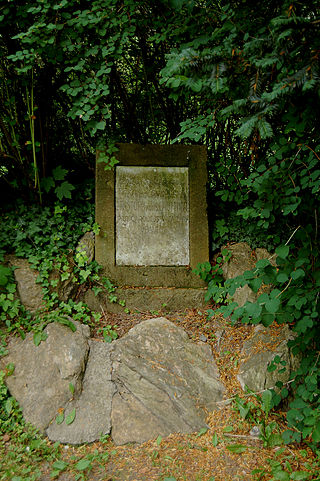Related Research Articles
The Aix-en-Provence possessions were a series of alleged cases of demonic possession occurring among the Ursuline nuns of Aix-en-Provence in 1611. Father Louis Gaufridi was accused and convicted of causing the possession by a pact with the devil, and he was tortured by strappado and his bones dislocated. He was then executed on April 1611 by strangulation and his body burned. This case provided the legal precedent for the conviction and execution of Urbain Grandier at Loudun more than 20 years later. This event led to possessions spreading to other convents and a witch burning in 1611.

The Loudun possessions, also known as the Loudun possessed affair, was a notorious witchcraft trial that took place in Loudun, Kingdom of France, in 1634. A convent of Ursuline nuns said they had been visited and possessed by demons. Following an investigation by the Catholic Church, a local priest named Urbain Grandier was accused of summoning the evil spirits. He was eventually convicted of the crimes of sorcery and burned at the stake.

The Basque witch trials of the seventeenth century represent the last attempt at rooting out supposed witchcraft from Navarre by the Spanish Inquisition, after a series of episodes erupted during the sixteenth century following the end of military operations in the conquest of Iberian Navarre, until 1524.
The witch trials of Vardø were held in Vardø in Finnmark in Northern Norway in the winter of 1662–1663 and were one of the biggest in Scandinavia. Thirty women were put on trial, accused of sorcery and making pacts with the Devil. One was sentenced to a work house, two tortured to death, and eighteen were burned alive at the stake.
Christence (Christenze) Akselsdatter Kruckow was a Danish noblewoman who was executed for witchcraft after having been accused twice. She is one of the most well known victims of the witch hunt in Denmark, and one of few members of the nobility to have been executed for sorcery in Scandinavia, and the only one in Denmark.

Anne Palles was an alleged Danish witch. She was the last woman to be legally executed for sorcery in Denmark.

Northern Moravia witch trials, also known as Boblig witch trials was a series of witch trials which occurred in the Jeseník (Freiwaldau) and Šumperk area in the present-day Czech Republic, between 1622 and 1696. They are among the largest and most well known Czech witch trials.

The trials of the Pendle witches in 1612 are among the most famous witch trials in English history, and some of the best recorded of the 17th century. The twelve accused lived in the area surrounding Pendle Hill in Lancashire, and were charged with the murders of ten people by the use of witchcraft. All but two were tried at Lancaster Assizes on 18–19 August 1612, along with the Samlesbury witches and others, in a series of trials that have become known as the Lancashire witch trials. One was tried at York Assizes on 27 July 1612, and another died in prison. Of the eleven who went to trial – nine women and two men – ten were found guilty and executed by hanging; one was found not guilty.
The Thisted witch trial, also known as Besættelsen i Thisted, took place in Thisted in Denmark in 1696–1698. It has been referred to as the last witch trial in Denmark, and the end of the belief in witchcraft among the Danish authorities.
The Channel Islands Witch Trials were a series of witch trials in the Channel Islands of Jersey and Guernsey between 1562 and 1661.
The Lisbon witch trial took place in 1559-1560 and resulted in the execution of six women for witchcraft. The trial in Lisbon resulted in a general inquiry of witchcraft in Portugal, which resulted in 27 additional people being accused, and one more receiving a death sentence the following year. This was arguably the only witch trial with multiple death sentences that ever took place in Portugal.
Margaret Bane also called Clerk, was a Scottish midwife and prominent victim of The Great Scottish Witch Hunt of 1597.

Witchcraft in Orkney possibly has its roots in the settlement of Norsemen on the archipelago from the eighth century onwards. Until the early modern period magical powers were accepted as part of the general lifestyle, but witch-hunts began on the mainland of Scotland in about 1550, and the Scottish Witchcraft Act of 1563 made witchcraft or consultation with witches a crime punishable by death. One of the first Orcadians tried and executed for witchcraft was Allison Balfour, in 1594. Balfour, her elderly husband and two young children, were subjected to severe torture for two days to elicit a confession from her.
Johan Pistorius, was a Danish grenadier. He was judged guilty of making a Satanic pact, and was the last person executed for witchcraft in Denmark.

Sweden was a country with few witch trials compared to other countries in Europe. In Sweden, about four hundred people were executed for witchcraft prior to the last case in 1704. Most of these cases occurred during a short but intense period; the eight years between 1668 and 1676, when the witch hysteria called Det stora oväsendet took place, causing a large number of witch trials in the country. It is this infamous period of intensive witch hunt that is most well known and explored.

The Witch trials in France are poorly documented, mainly because a lot of the documents of former witch trials have not been preserved, and no number can therefore be given for the executions of witch trials in France or the true extent of them. While there is much secondary information about witch trials in France, the poor state of documentation often makes them hard to confirm.

The Witch trials in Denmark are poorly documented, with the exception of the region of Jylland in the 1609–1687 period. The most intense period in the Danish witchcraft persecutions was the great witch hunt of 1617–1625, when most executions took place, which was affected by a new witchcraft act introduced in 1617.
The witch trials in Norway were the most intense among the Nordic countries. There seems to be around an estimated 277 to 350 executions between 1561 and 1760. Norway was in a union with Denmark during this period, and the witch trials were conducted by instructions from Copenhagen. The authorities and the clergy conducted the trials using demonology handbooks and used interrogation techniques and sometimes torture. After a guilty verdict, the condemned was forced to expose accomplices and commonly deaths occurred due to torture or prison. Witch trials were in decline by the 1670s as judicial and investigative methods were improved. A Norwegian law from 1687 maintained the death penalty for witchcraft, and the last person to be sentenced guilty of witchcraft in Norway was Birgitte Haldorsdatter in 1715. The Witchcraft Act was formally in place until 1842.
The Witches of Bo'ness were a group of women accused of witchcraft in Bo'ness, Scotland in the late 17th century and ultimately executed for this crime. Among the more famous cases noted by historians, in 1679, Margaret Pringle, Bessie Vickar, Annaple Thomsone, and two women both called Margaret Hamilton were all accused of being witches, alongside "warlock" William Craw. The case of these six was "one of the last multiple trials to take place for witchcraft" in Scotland.

During a 104-year period from 1626 to 1730, there are documented Virginia Witch Trials, hearings and prosecutions of people accused of witchcraft in Colonial Virginia. More than two dozen people are documented having been accused, including two men. Virginia was the first colony to have a formal accusation of witchcraft in 1626, and the first formal witch trial in 1641.
References
- ↑ Mona Chollet (2018). Sorcières: La puissance invaincue des femmes (in French). Paris: La Découverte. ISBN 978-2-35522-122-4. OCLC 1046671440. OL 31847045M. Wikidata Q105870892.
- [ permanent dead link ] (In French)
- Robert Muchembled, Les derniers bûchers, Ramsay, Paris